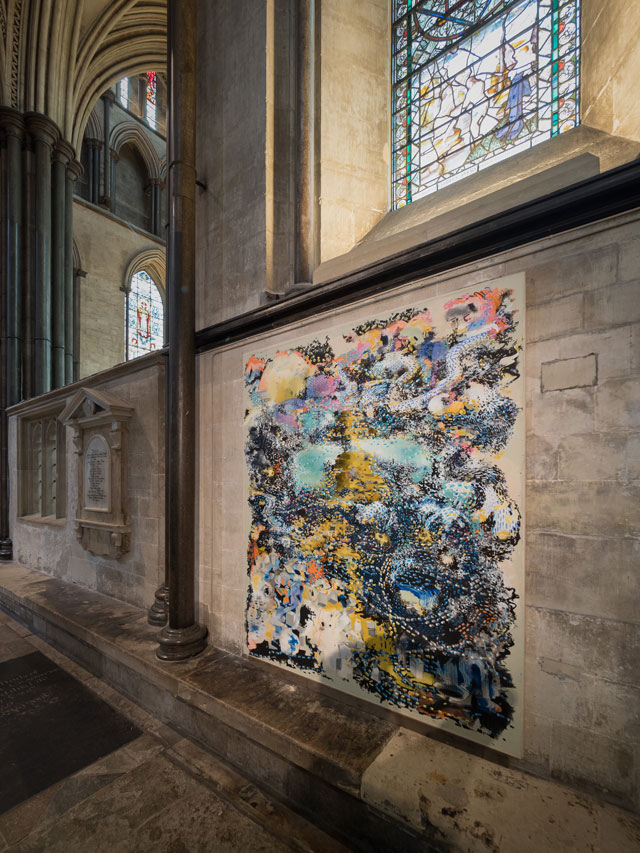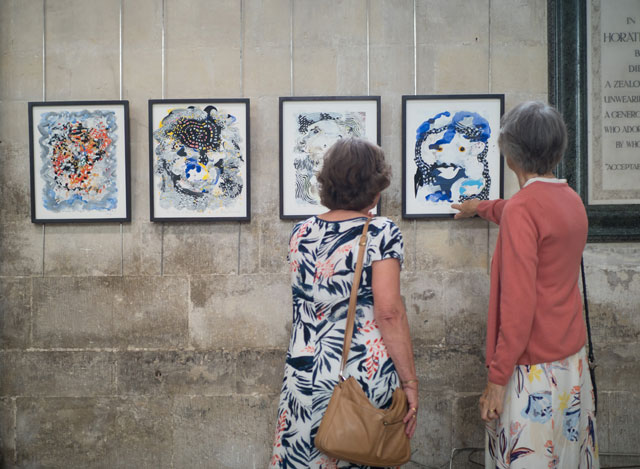

by JANET McKENZIE
Stephen Farthing’s Miracle paintings are on show for the first time at Salisbury Cathedral, and Jacquiline Creswell, the cathedral’s visual arts adviser, has created a sense of personal quest or journey in the hang of the works. She explains: “Stephen wants the paintings to be shown together in a context where faith may be celebrated. Every day, we take for granted all that is miraculous around us, from music to sight, from breathing to birth. He takes those seemingly everyday miracles and captures the mystical energy that lies behind them. These paintings have never been seen before, as Stephen wished for them to be shown together in a context where these concepts may be realised, a space where faith may be celebrated.”
[image10]
Created over a seven-year period (2012-18), the Miracle paintings were not intended as illustrations of particular episodes; rather they were intended to capture the inherent energy and mystery of a miraculous experience. Farthing believes: “What makes an event, or indeed a painting, ‘miraculous’, is our inability to explain it in any other terms than by saying, ‘This is what I saw.’”
The Miracle paintings inhabit the cathedral and interact visually with the vast lexicon of biblical references within the architecture itself, the gilded and painted bas-relief sculptures, the carved doors and stained-glass windows. Somewhat like the effect of a vast spatial drawing the paintings act as markers along the spiritual journey, as if they had been there for a century or more, yet the language is emphatically contemporary, mining the deepest subconscious experiences of thought, birth, learning, flight, hearing and the unknown. The works present the personal and universal in one.
[image11]
Attending the exhibition is an experience of unusual significance, where the existing drama and allusions to Paradise and the biblical narrative exist side-by-side with the personal spiritual experience. Farthing’s Miracles embrace quotidian realities so one feels that they are grounded in real life and they are never condescending although they are unashamedly reaching for transcendence. Where the priest leads the liturgy and the congregation takes part, the artist here provides a rich manner of visual cues for the viewer to share and embrace. The Miracle paintings act as symbolic markers in an architectural space designed to celebrate light and hope. Farthing’s Miracle paintings were conceived in Cairo, Egypt, in 2011, following a conversation with a Coptic priest about miracles.
[image12]
Hung beneath vast stained-glass windows, the inscrutability of the works is ironically provided with prompts from the building itself, the pinnacle of construction with the profound ambition to praise God, to emulate Paradise. The Miracle paintings are a synthesis of supposed opposites; they are intended to be iconic and reflective, and are both legible and inscrutable.
Janet McKenzie: The first picture we encounter is The Miracle of Thought (2016) although it is not, in chronological terms, the first painting you made for the series. The surface of the work is densely covered with short brush marks in white paint that almost conceal the painting behind it.
Stephen Farthing: The white brush marks came at the end and were applied to what was a fully chromatic painting. I painted over the underlying image to a point that it was almost obliterated. I did it because, by the time I had arrived at a point where I felt I could finish this painting, I was near to the end of the series (the third to last painting). I felt I had done what I had set out to do, so felt free to do something that would represent a departure, to take some bigger risks and try to break new ground – the idea of trying to paint the miraculous, the idea that there might be something that is difficult to explain, but it might also be something that is difficult to see. The idea behind the white brush marks was to create a loss of focus. What then happened was that, in trying to paint a loss of focus, other unexpected elements came into focus. The image of the duck-rabbit that occupies the centre of this painting was not something I planned on having there; it was something that grew. And once it began to grow, I decided I would go with the flow and fully develop it as an image. It does not become the miracle of the duck and the rabbit, but the miracle of thought. Therefore, it is not what I see, but what I think that I see. The thought, as far as I am concerned, is the beginning of any form of communication.
[image13]
JMcK: How did this work evolve from the smaller works on paper, The Miracle of Duck, Rabbit, Fish (2016) and The Miracle of the Duck (2015)? Is it your subconscious thought processes that you are capturing?
SF: It’s probably 80% subconscious. The works on paper were all made with a view towards discovering if the ideas that were emerging through a dominantly spontaneous approach to painting could be developed further, in perhaps a second or third painting, so they are not so much preparatory works as parallel excavations. As it happens, each of the works that focus on the image of the duck-rabbit are the only works on paper that went on to influence what happened on canvas. Every other painting in the series was made directly on to the canvas without the influence of preparatory drawings. As a result of this working process, the subconscious has, as you suggest, been allowed to play a significant role in shaping these images.
JMcK: The circular parts seem to have evolved organically, as a life force that evolves from the creative process.
SF: I see the circular elements as forces of energy from which the thing is formed. So, what I have done is create a field of colour, which I then began to obliterate with unapplied energy – and out of that energy, this image is generated.
JMcK: It recalls the Deluge, in art and in biblical terms.
SF: Images of the deluge interest me because it is only, I suspect, when the destructive motion is slowed down or arrested (as it is in a two-dimensional image) that it is possible for us to see the bigger picture and to begin to understand what is happening. The Deluge need not be an entirely negative force: it is, after all, only through destructive acts, within the act of a painting, that is, that I believe I can get near to understanding what I value.
[image5]
JMcK: The next painting is The Miracle of the Deep (2013), and it is slightly sinister.
SF: All these paintings have their roots in Egypt, where I had a conversation with a Coptic priest about miracles that got me thinking about how on earth you go about painting the miraculous. I came to the conclusion that what I had to do was not so much tell a story as set up a condition or state of affairs where something unexpected – probably something good and unexpected – came out of it.
The roots of this painting are from snorkelling over a reef in the Red Sea in Egypt. The painting is based on an external experience, so on a different kind of experience from The Miracle of Thought. It consciously celebrates the enjoyment of using paint and colour. The extraordinary thing for me about deep snorkelling is that it is both beautiful and frightening. In the sea, you swim with highly coloured fish with amazing eyes in an intensely beautiful place. In the deeper areas, it is a different experience altogether. The deepest parts of the ocean are, for me, too deep to enter. As a result, I can only imagine them with a sense of foreboding. I sought to embody the act of swimming into the deep within the act of painting itself. I ended up creating a space that has an energy that I hope I have shared.
[image7]
JMcK: The manner in which your paintings are hung within the cathedral is very sensitive to the detail and symbolism of the building. In turn, the paintings echo the spirit-filled journey that any individual makes, acting as markers along the spiritual journey, which is an incredible experience. Did you set out to create iconic works?
SF: From the beginning, I was trying in each of the paintings to create a strong iconic – therefore, not a narrative – presence. Each image set out to encourage a different kind of emotional and possibly intellectual reflection. Together, I think of them as chapters in a book or, now, hung in an architectural space and place, yes, they are a journey.
JMcK: Can we come close up to the small drawings? The Miracle of Flight I (2015), The Miracle of Duck, Rabbit, Fish and The Miracle of Hearing (2015) draw me towards them from some distance, and they remind me of the Deluge.
SF: I am interested that you see that connection because I first made work in relation to the Deluge at the time of the Leonardo exhibition that Martin Kemp put together in 1989, when I was artist in residence at the Hayward Gallery. As a result of being artist in residence, I did a lot of work based on Leonardo’s Deluge drawings. Leonardo drew deluges but did not paint them. He couldn’t paint them, he didn’t have the ability to paint them, but he had a graphic language that enabled him to reduce the deluge to a pen and ink line. During the exhibition, I made paintings from his drawings. His understanding of motion was what attracted me. In the end, it was postmodernism that made it possible for me to paint from the graphic work of Leonardo. In one way or another all of the works here on display in this cathedral are fathered by the drawings Leonardo made when he lived on the Loire at the end of his life, the images of closely observed water and heaving landscapes and skies.
JMcK: It is interesting in the context of your Miracle paintings that we chose to include the Leonardo Codex in the book we edited together, The Drawn Word. You particularly wanted an essay by Martin Kemp on the interface between word and image in Leonardo’s work.
SF: Leonardo demonstrates on page after page of his notebooks that the distance between writing and drawing is not that great. His annotated drawings and illustrated writings are what are important to me, he painted very beautiful, classically iconic paintings but, with pen and ink, he elegantly explored a host of ferociously modern ideas.
JMcK: In The Drawn Word and in previous conversations, we have talked about the relationship between word and image in your work. When I look at The Miracle of Thought and the three works on paper, the marks or stippling behave visually somewhat like small words. The layering of poetic mark-making enables word and mark-making to be almost interchangeable.
SF: Whether I paint or draw, words are always going through my head. My mind is never blank; my thoughts are sounds that I translate into two-dimensional images, some written but most often drawn.
JMcK: These seem political and it is not because of the checked cloth or the turban in this drawing, or the inclusion of a tiny aeroplane, but by the nature of their fluidity, of their movement, they imply political instability and drama. The order that your Abacus paintings (2010) imply, in formal terms could be seen to have been deconstructed, in The Miracle of Flight, as if the components of Abacus have been struck by a hurricane?
SF: If that is so, I think it is because I do take notice of what is going on outside the studio, and this series of paintings was started about six months after the start of what has become known as the Arab spring. At about that time, I spent a lot of time in Egypt seeing demonstrations, seeing change. Ever since the Arab spring, the world has been churning in a way that’s impossible to ignore.
To exhibit in this magnificent 800-year-old cathedral is incredible. It’s humbling. It’s late afternoon and we are still looking at the works in soft, natural light. This is the best group show I’ve ever been in! These paintings were not painted with the view to being exhibited here at Salisbury Cathedral, or indeed any cathedral or place of worship. They were painted in a white-walled studio in Pimlico, but they seem so much more at home here.
[image6]
JMcK: We are in the next room and looking at The Miracle of the Hand Made (2012) and The Miracle of the Book (2012). It is by chance that the forms within the painting can be seen to echo forms within the cathedral, such as the book shape and size matching the stone blocks that make the walls as well as the grid in the stained-glass windows. The materials of the building form a backdrop of aged patina in contrast to the new work. Can you tell me about these works?
SF: It’s easy to explain the starting point, but what intrigues me more is where I end up, which is far more difficult for me to explain. The beginning was the story of the writing of the Qur’an. The miracle of the Qur’an is that it was delivered to Muhammad in a cave, in episodes, by an illiterate person who had received a visitation from God. Muhammad was able to retell the stories to scribes who wrote them down. The idea of all religions is that books are built out of words. The writing in The Miracle of the Hand Made is not to be read for meaning, but it is a continuation of its presence in The Miracle of the Book. The word, both spoken and written, is an essential ingredient of our understanding of the miraculous. It is also how we share our understanding of miraculous events.
JMcK: We are on the other side of the cathedral now and looking back at The Miracle of Our Earth (2018). It looks quite remarkable at this angle.
SF: The Miracle of Our Earth is an image of Mokattam Mountain. It was the last painting in the series and was made in Amman in Jordan, where I now live. The painting is made around an image of one of the hills outside my studio, so it is what I see through the window every day. It’s not at first sight much like a landscape. Within it, there are trees and the dusty high desert – most of the year, it’s ochre and, for three months of the year, it is green. There are sheep and Bedouins, not in the painting but out there in real life. What the painting shows is like a moment of creation, an apocalyptical moment that I think relates closely to the Deluge paintings that are dotted through art history. The painting gives us a view of an earth that is a growing changing thing, not a static entity. The Miracle of Our Earth represents a sandstorm and a moment of creation and destruction, of aridity, but there are two areas of turquoise that represent sources of water, so, to my mind, life and hope.
[image4]
The Miracle of Song (2104) is the image of a continuous piano keyboard that has, note by note, been reshaped through the manual act of painting. Most of the paintings started with a flat repeat image: in The Miracle of Our Earth, the image of a mountain is repeated across the canvas. In The Miracle of Money (2106), a 100-yen note is still visible as a repeat image across the entire surface. Once the canvas is filled, I begin to play with the flat surface: I try to raise the mountain, or the arrangement of birds on the piano keyboard as if they were the words of a song. I try to fault the logic of the repeat pattern that the paintings begin with. Then, I introduce a source of energy, not just with shapes but something with a velocity that blows the imagery into a shape. In big terms, I want these paintings to be understood as optimistic – not pessimistic – as examples of the miracle of painting.
[image9]
JMcK: That sentiment is especially so in The Miracle of Birth (2016).
SF: It is a painting that pictures something growing out of a set of circumstances to become something else. As the father of three children, I believe the greatest miracle of all is that of a child being born, then developing a life of its own. In this painting, I started with a repeat pattern of a bird across the painting – it looked like wallpaper. Then, as I gradually corrupted the pattern, it became a meeting of birds, each of a slightly different shape. Finally, I made the image appear to be an embroidered piece of textile that was hung across a wall.
JMcK: The mark-making is therefore like sewn stitches.
SF: This painting has been constructed using a similar brush stroke to those used in The Miracle of the Book. During the making of that painting, I thought of the brushstrokes as letters, or a piece of a word, that grew during the act of painting into sentences, but while I was painting The Miracle of Birth, I thought of each brush stroke as a stitch that embroidered the fabric I was painting on. In The Miracle of Thought, the white brush strokes were mosaic tiles that obscured information
JMcK: Can you describe the top areas punctuated by the rings?
SF: I first saw the painted image of a cloth draped from metal rings in 1976, in the Sistine Chapel. As the walls rise from the floor to just above head height to a point just below Pietro Perugino’s narrative paintings, there is the painted image of a draped golden cloth with a repeat patterning meandering its way around the chapel. During the process of making my painting, this became the imaginary surface on which the action would unfold. Seeing my painting today occupying a similar architectural space to the painted golden curtain in the Sistine Chapel, that is beneath the stained glass on the nave of the cathedral – is a truly humbling experience.
• The Miracle Paintings by Stephen Farthing are on show at Salisbury Cathedral, Wiltshire, courtesy of Candida Stevens Gallery, until 23 October 2018.
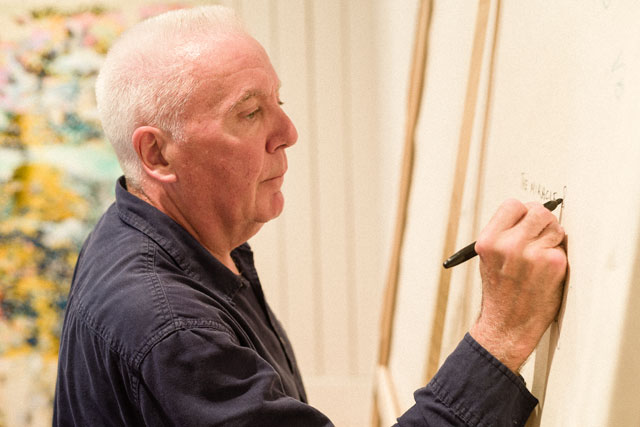

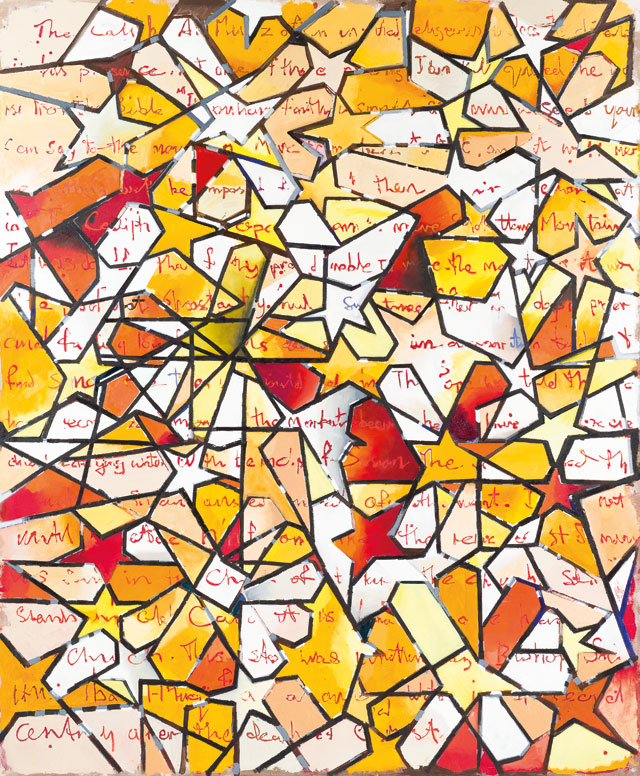
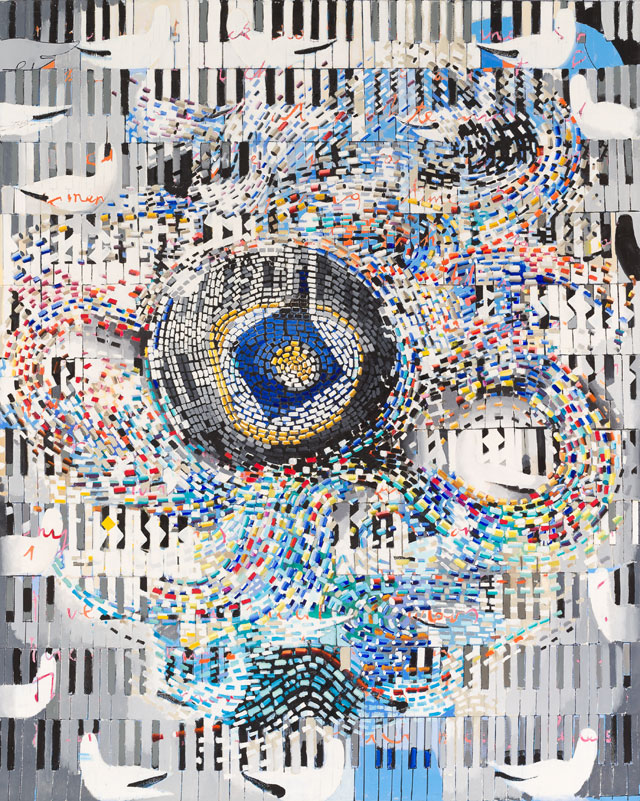
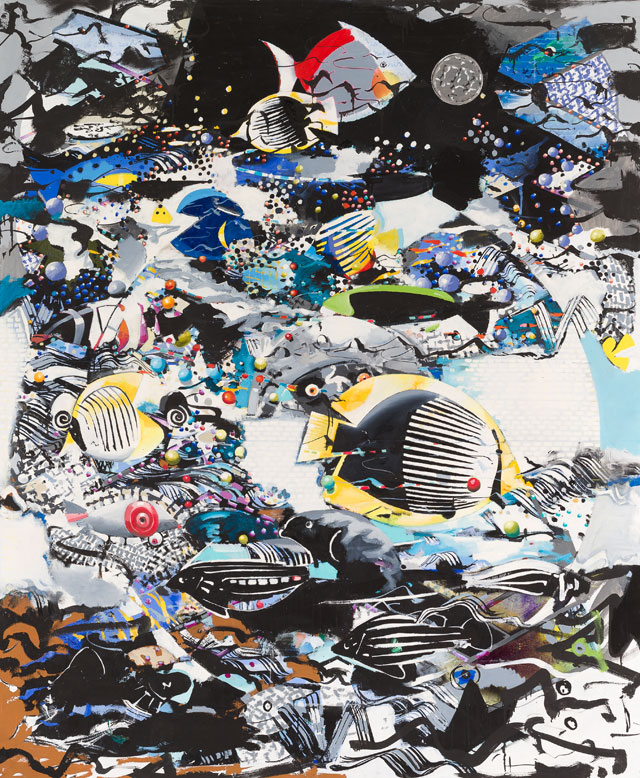
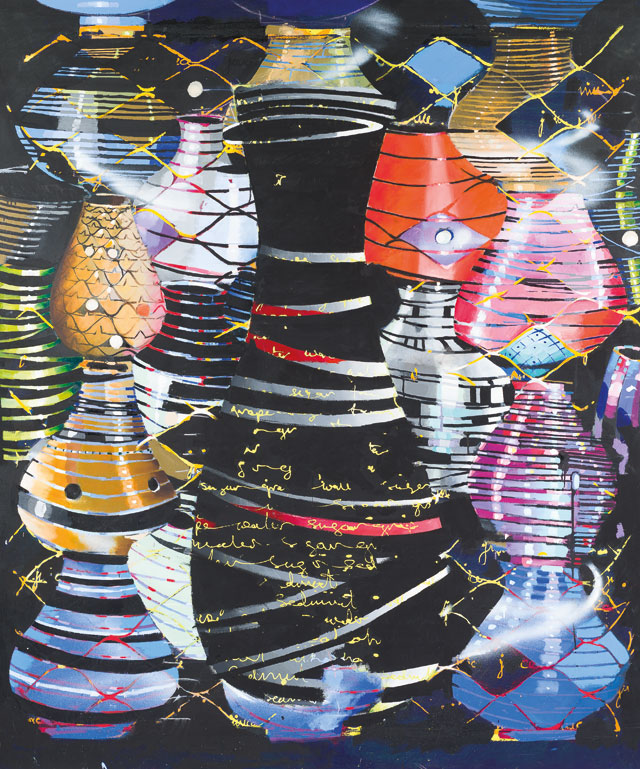
-and-The-Miracle-of-the-Deep-(r)---photo-by-Ash-Mills.jpg)
.jpg)
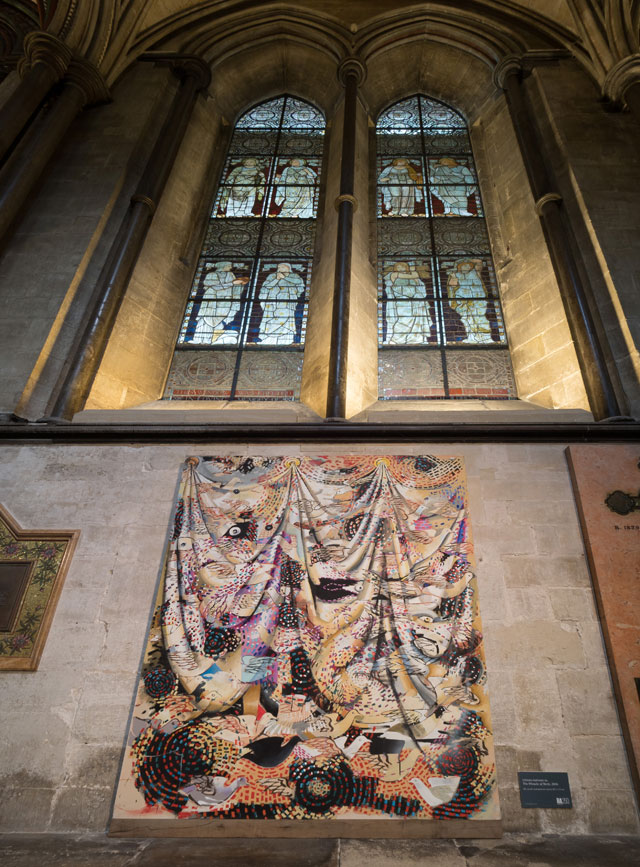
.jpg)
-and-The-Miracle-of-The-Deep(r-)-by-Stephen-Farthing-RA---photo-by-Ash-Mills.jpg)
